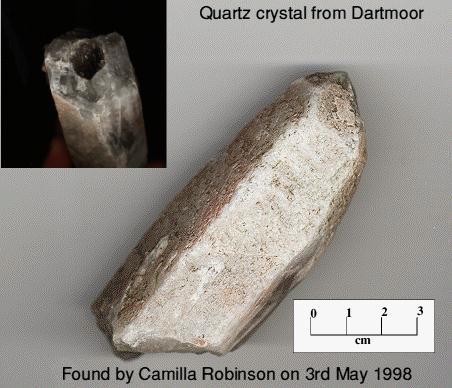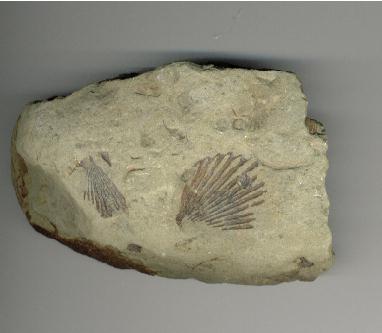
The three main minerals
in granite can be seen in this polished cross-section.
Black=Mica,
White=Feldspar, Grey =Quartz
The Three Main Rock Groups
It was James Hutton (1727-1797), the famous 18th century geologist, who popularised the idea of a Rock Cycle, demonstrating the relationships between igneous, sedimentary and metamorphic rocks. The Rock Cycle relies on the upper part of the earth ( mantle, crust and surface) acting like an automatic recycling system. The material from which rocks are made isn't destroyed when they are weathered and eroded, but is recycled, forming new types of rocks. This process is continuous and is assumed to have worked in the same ways since the earth was formed.
There are many different rocks on the Earth and other planets, but every single one can be fitted into one of the three main groups; Igneous, Metamorphic and Sedimentary.
The groups are defined according to the origins of the rocks. In other words, the way in which a rock is created determines the group to which it belongs. Within each group the characteristics of the rocks can vary greatly, in colour, hardness, mineral composition and texture, but they will all have a common type of origin.
Let's look briefly at each of the groups.
Igneous
Rocks
The word Igneous comes from the latin,
ignis, meaning fire. In ancient times volcanoes, the source of many
igneous rocks were thought to be mountains that were on fire, so the rocks
were known as fire rocks. We now use the term to describe all rocks that
have been formed from molten rock, whether they formed on the surface or
at depth within the planet.
As we have seen in previous lessons, molten rock below the surface is known as magma and when it flows out onto the surface it becomes known as lava. Just as the name of the molten rock material changes, so does the name given to the types of rock it forms. Rocks formed from cooling magma are known as intrusive igneous rocks; rocks formed from cooling lava are known as extrusive igneous rocks.
An important characteristic of igneous rocks is that they are crystalline, or made of crystals. The basic components of igneous rocks are minerals, each of which has a fixed chemical composition. Each mineral forms a characteristic type of crystal. For example, the well known igneous rock, Granite, is composed of three main minerals, Quartz, Mica and Feldspar, all of which look different and can be clearly seen in a sample.

The three main minerals
in granite can be seen in this polished cross-section.
Black=Mica,
White=Feldspar, Grey =Quartz
The size of the crystals is usually determined by the speed at which the molten rock material cools. Quick cooling produces small crystals, slow cooling produces larger crystals.

A well developed quartz
crystal found on Dartmoor, Devon, by a junior school pupil
The size of the crystals can be used to further classify igneous rocks.
Metamorphic
Rocks
These are rocks of either Igneous or
Sedimentary origins that have been altered due to heat and/or pressure,
with some help from chemically active fluids. The word comes from the
Greek words , meta, meaning change, and morphe, meaning
form. No melting is involved and the rocks remain solid all the time,
though they may become folded and contorted by vast pressures.
The only sources of intense heat and pressure lie below the surface so that is where all metamorphic rocks must form. The only times we see them are when upper layers of rock are eroded away, exposing the layers formed at depth.
Although most metamorphic rocks form very deep within the crust, it is possible for rocks relatively close to the surface to undergo metamorphism if igneous rocks are intruded close by. The intense heat from the igneous rocks can literally cook the surrounding rocks, altering their character and composition. In this way, limestone can become marble, and shale be converted to slate.
Sedimentary
Rocks
These rocks are created from sediments, the
broken up particles of other older rocks. Common rocks such as chalk,
sandstone and clay are sedimentary rocks formed from the accumulation of
eroded material on the Earth's surface.
Uniquely among the three main rock groups, we can actually watch sediments settle out of muddy water, and gathering in layers along the bed of a stream. This means that we can observe the processes that form sedimentary rocks. The Principle of Uniformitarianism enables us to conclude, with a few reservations, that the processes we can see happening today, are the same ones that formed the sedimentary rocks around us thousands or millions of years ago.
There are several ways to classify sedimentary rocks, but a common one is according to the process which led to their deposition.
Rocks formed from
particles of older eroded rocks are known as Clastic rocks. These
include sandstones and clays.
Rocks formed from plant and animal remains
are known as Organic. These include Limestone, Chalk and Coal.
Rocks formed from chemical action are known
as Chemical. These include sedimentary iron ores, evaporites such
as rock salt (Halite), and to some extent flint, limestone and chert.
Clues that may help you recognize a sedimentary rock are...

Fine grained sandstone
with fossil shell imprints - clear evidence that it's a sedimentary rock.
Activities
You will have to carry out some research of your own to solve some of these problems...
1.
Classify these rocks according to the groups to which they belong. Give
brief reasons to explain why they belong to the groups you choose:
Granite,
Mudstone, Shale, Slate, Basalt, Sandstone, Marble, Limestone, sand on the
beach, a gritty rock full of fossils, a tomb stone that seems to be made
of pink, black and white crystals.
2. Two igneous rocks are collected near the same volcano. One has mostly large crystals, the other has mostly small crystals. What can you say about the conditions under which each rock formed?
3.
Research at least 10 different types of rocks that are quarried or mined.
For each rock explain what it is used for, and why it is used rather than
another rock.
For example, you
might choose slate, a metamorphic rock that is used for roofing houses.
Why do we use slate on a roof rather than chalk or granite?
4.
Look around your home or school for examples of rocks used for building,
ornaments or furniture. Look for clues as to their origins. To which of
the three main rock groups do they belong? Explain why.
|
|
|
Click to go back